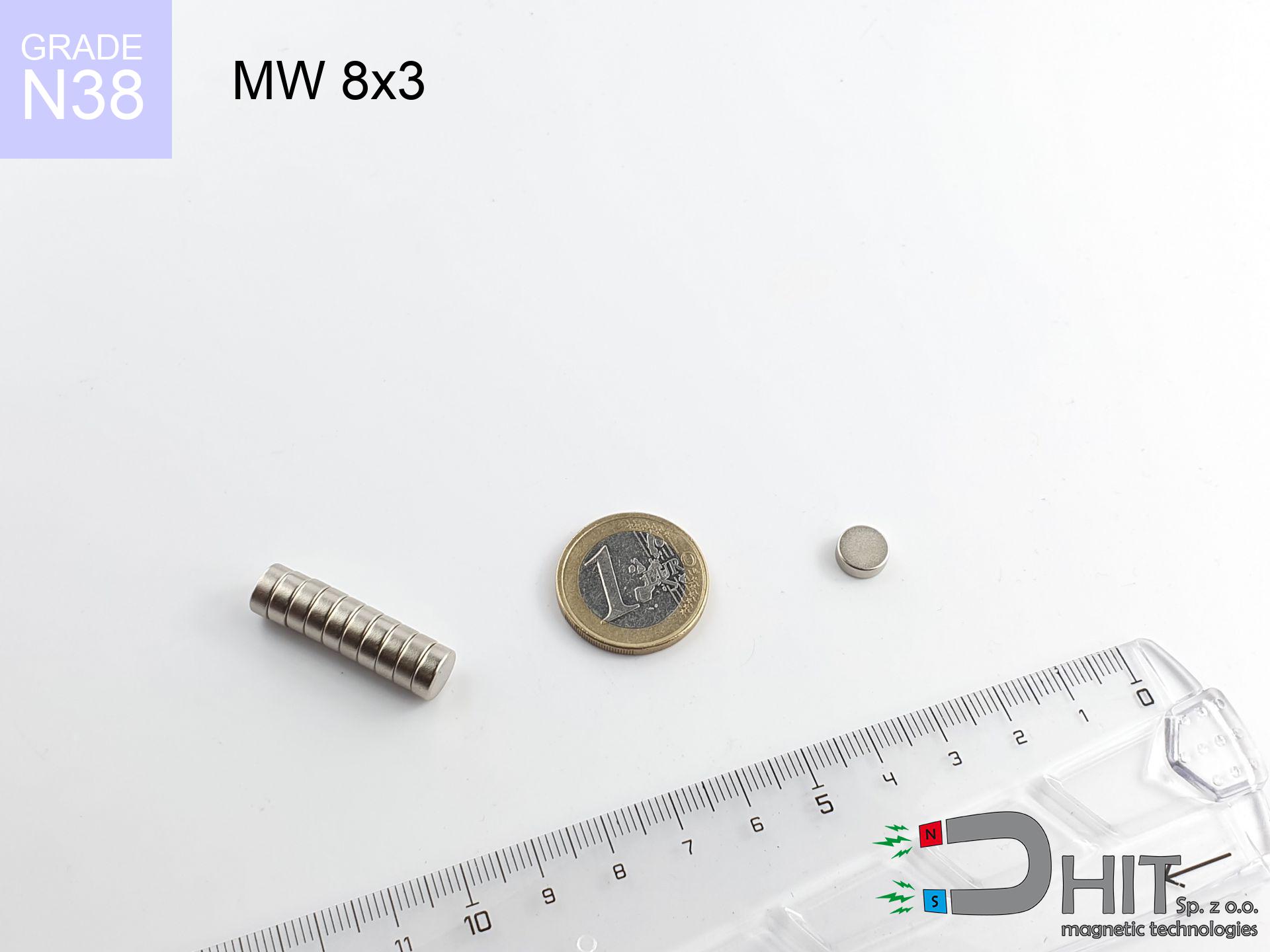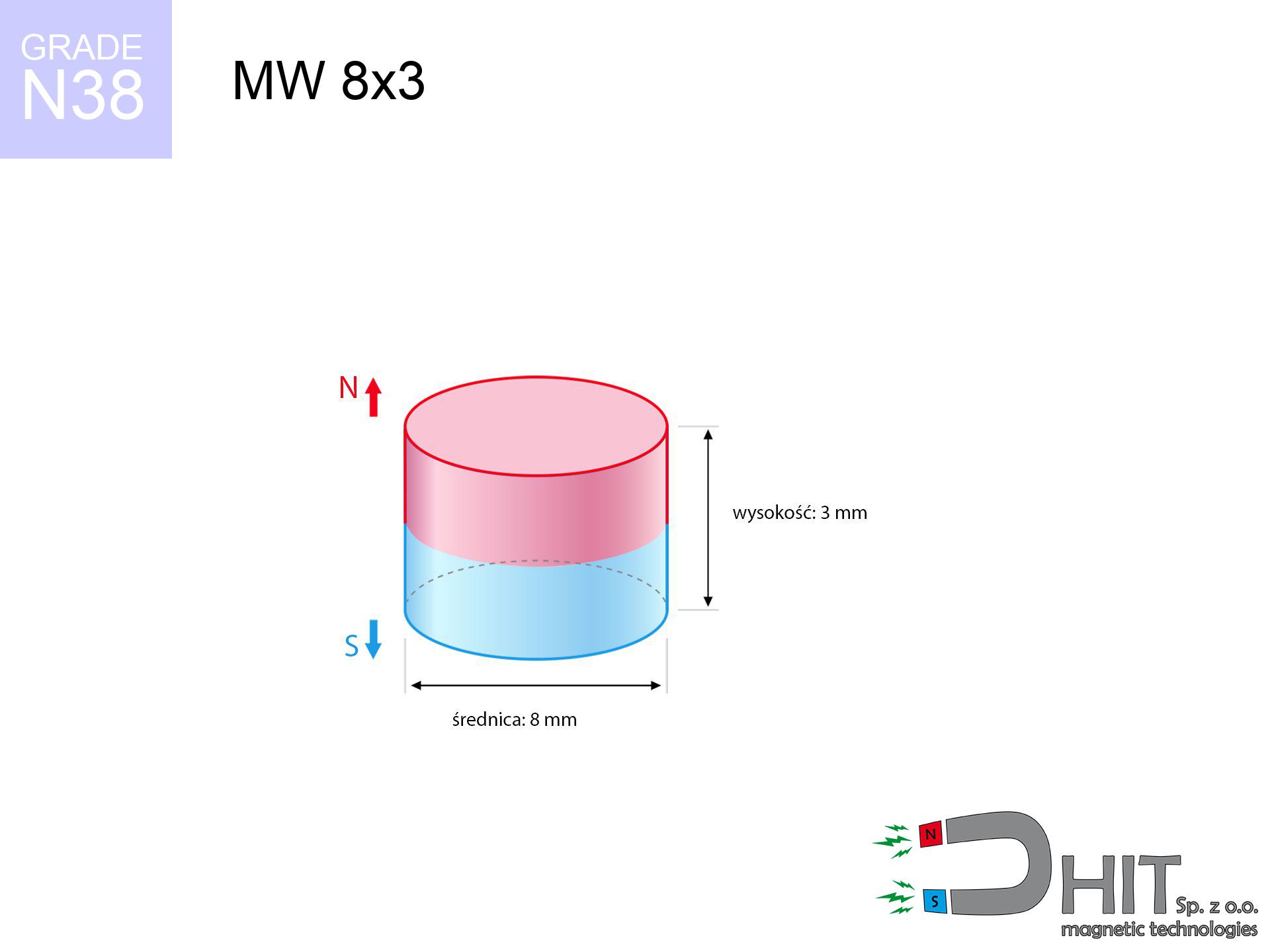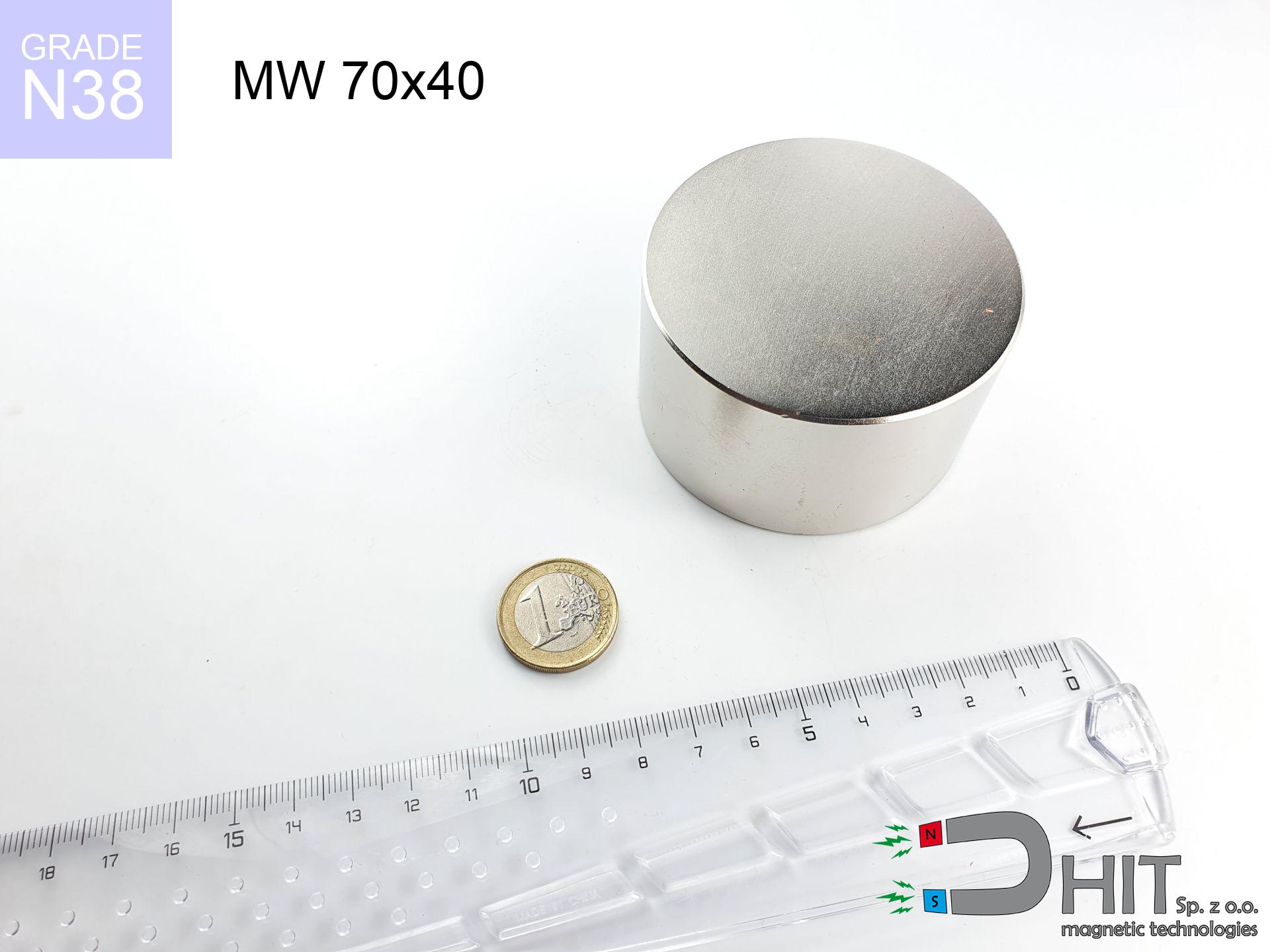MW 8x3 / N38 - cylindrical magnet
cylindrical magnet
Catalog no 010103
GTIN/EAN: 5906301811022
Diameter Ø
8 mm [±0,1 mm]
Height
3 mm [±0,1 mm]
Weight
1.13 g
Magnetization Direction
↑ axial
Load capacity
1.70 kg / 16.67 N
Magnetic Induction
371.53 mT / 3715 Gs
Coating
[NiCuNi] Nickel
0.701 ZŁ with VAT / pcs + price for transport
0.570 ZŁ net + 23% VAT / pcs
bulk discounts:
Need more?Do you have trouble choosing?
Pick up the phone and ask
+48 888 99 98 98
or get in touch via
contact form
through our site.
Weight as well as form of a neodymium magnet can be reviewed using our
online calculation tool.
Same-day shipping for orders placed before 14:00.
MW 8x3 / N38 - cylindrical magnet
Specification / characteristics MW 8x3 / N38 - cylindrical magnet
| properties | values |
|---|---|
| Cat. no. | 010103 |
| GTIN/EAN | 5906301811022 |
| Production/Distribution | Dhit sp. z o.o. |
| Country of origin | Poland / China / Germany |
| Customs code | 85059029 |
| Diameter Ø | 8 mm [±0,1 mm] |
| Height | 3 mm [±0,1 mm] |
| Weight | 1.13 g |
| Magnetization Direction | ↑ axial |
| Load capacity ~ ? | 1.70 kg / 16.67 N |
| Magnetic Induction ~ ? | 371.53 mT / 3715 Gs |
| Coating | [NiCuNi] Nickel |
| Manufacturing Tolerance | ±0.1 mm |
Magnetic properties of material N38
| properties | values | units |
|---|---|---|
| remenance Br [min. - max.] ? | 12.2-12.6 | kGs |
| remenance Br [min. - max.] ? | 1220-1260 | mT |
| coercivity bHc ? | 10.8-11.5 | kOe |
| coercivity bHc ? | 860-915 | kA/m |
| actual internal force iHc | ≥ 12 | kOe |
| actual internal force iHc | ≥ 955 | kA/m |
| energy density [min. - max.] ? | 36-38 | BH max MGOe |
| energy density [min. - max.] ? | 287-303 | BH max KJ/m |
| max. temperature ? | ≤ 80 | °C |
Physical properties of sintered neodymium magnets Nd2Fe14B at 20°C
| properties | values | units |
|---|---|---|
| Vickers hardness | ≥550 | Hv |
| Density | ≥7.4 | g/cm3 |
| Curie Temperature TC | 312 - 380 | °C |
| Curie Temperature TF | 593 - 716 | °F |
| Specific resistance | 150 | μΩ⋅cm |
| Bending strength | 250 | MPa |
| Compressive strength | 1000~1100 | MPa |
| Thermal expansion parallel (∥) to orientation (M) | (3-4) x 10-6 | °C-1 |
| Thermal expansion perpendicular (⊥) to orientation (M) | -(1-3) x 10-6 | °C-1 |
| Young's modulus | 1.7 x 104 | kg/mm² |
Technical analysis of the magnet - technical parameters
Presented values constitute the result of a physical analysis. Values rely on algorithms for the material Nd2Fe14B. Actual performance may differ from theoretical values. Please consider these calculations as a reference point for designers.
MW 8x3 / N38
| Distance (mm) | Induction (Gauss) / mT | Pull Force (kg) | Risk Status |
|---|---|---|---|
| 0 mm |
3712 Gs
371.2 mT
|
1.70 kg / 1700.0 g
16.7 N
|
weak grip |
| 1 mm |
2880 Gs
288.0 mT
|
1.02 kg / 1023.3 g
10.0 N
|
weak grip |
| 2 mm |
2069 Gs
206.9 mT
|
0.53 kg / 527.9 g
5.2 N
|
weak grip |
| 3 mm |
1439 Gs
143.9 mT
|
0.26 kg / 255.3 g
2.5 N
|
weak grip |
| 5 mm |
704 Gs
70.4 mT
|
0.06 kg / 61.1 g
0.6 N
|
weak grip |
| 10 mm |
169 Gs
16.9 mT
|
0.00 kg / 3.5 g
0.0 N
|
weak grip |
| 15 mm |
62 Gs
6.2 mT
|
0.00 kg / 0.5 g
0.0 N
|
weak grip |
| 20 mm |
29 Gs
2.9 mT
|
0.00 kg / 0.1 g
0.0 N
|
weak grip |
| 30 mm |
9 Gs
0.9 mT
|
0.00 kg / 0.0 g
0.0 N
|
weak grip |
| 50 mm |
2 Gs
0.2 mT
|
0.00 kg / 0.0 g
0.0 N
|
weak grip |
MW 8x3 / N38
| Distance (mm) | Friction coefficient | Pull Force (kg) |
|---|---|---|
| 0 mm | Stal (~0.2) |
0.34 kg / 340.0 g
3.3 N
|
| 1 mm | Stal (~0.2) |
0.20 kg / 204.0 g
2.0 N
|
| 2 mm | Stal (~0.2) |
0.11 kg / 106.0 g
1.0 N
|
| 3 mm | Stal (~0.2) |
0.05 kg / 52.0 g
0.5 N
|
| 5 mm | Stal (~0.2) |
0.01 kg / 12.0 g
0.1 N
|
| 10 mm | Stal (~0.2) |
0.00 kg / 0.0 g
0.0 N
|
| 15 mm | Stal (~0.2) |
0.00 kg / 0.0 g
0.0 N
|
| 20 mm | Stal (~0.2) |
0.00 kg / 0.0 g
0.0 N
|
| 30 mm | Stal (~0.2) |
0.00 kg / 0.0 g
0.0 N
|
| 50 mm | Stal (~0.2) |
0.00 kg / 0.0 g
0.0 N
|
MW 8x3 / N38
| Surface type | Friction coefficient / % Mocy | Max load (kg) |
|---|---|---|
| Raw steel |
µ = 0.3
30% Nominalnej Siły
|
0.51 kg / 510.0 g
5.0 N
|
| Painted steel (standard) |
µ = 0.2
20% Nominalnej Siły
|
0.34 kg / 340.0 g
3.3 N
|
| Oily/slippery steel |
µ = 0.1
10% Nominalnej Siły
|
0.17 kg / 170.0 g
1.7 N
|
| Magnet with anti-slip rubber |
µ = 0.5
50% Nominalnej Siły
|
0.85 kg / 850.0 g
8.3 N
|
MW 8x3 / N38
| Steel thickness (mm) | % power | Real pull force (kg) |
|---|---|---|
| 0.5 mm |
|
0.17 kg / 170.0 g
1.7 N
|
| 1 mm |
|
0.43 kg / 425.0 g
4.2 N
|
| 2 mm |
|
0.85 kg / 850.0 g
8.3 N
|
| 5 mm |
|
1.70 kg / 1700.0 g
16.7 N
|
| 10 mm |
|
1.70 kg / 1700.0 g
16.7 N
|
MW 8x3 / N38
| Ambient temp. (°C) | Power loss | Remaining pull | Status |
|---|---|---|---|
| 20 °C | 0.0% |
1.70 kg / 1700.0 g
16.7 N
|
OK |
| 40 °C | -2.2% |
1.66 kg / 1662.6 g
16.3 N
|
OK |
| 60 °C | -4.4% |
1.63 kg / 1625.2 g
15.9 N
|
|
| 80 °C | -6.6% |
1.59 kg / 1587.8 g
15.6 N
|
|
| 100 °C | -28.8% |
1.21 kg / 1210.4 g
11.9 N
|
MW 8x3 / N38
| Gap (mm) | Attraction (kg) (N-S) | Repulsion (kg) (N-N) |
|---|---|---|
| 0 mm |
4.27 kg / 4271 g
41.9 N
5 146 Gs
|
N/A |
| 1 mm |
3.40 kg / 3403 g
33.4 N
6 627 Gs
|
3.06 kg / 3063 g
30.0 N
~0 Gs
|
| 2 mm |
2.57 kg / 2571 g
25.2 N
5 761 Gs
|
2.31 kg / 2314 g
22.7 N
~0 Gs
|
| 3 mm |
1.87 kg / 1871 g
18.4 N
4 914 Gs
|
1.68 kg / 1684 g
16.5 N
~0 Gs
|
| 5 mm |
0.93 kg / 926 g
9.1 N
3 456 Gs
|
0.83 kg / 833 g
8.2 N
~0 Gs
|
| 10 mm |
0.15 kg / 154 g
1.5 N
1 408 Gs
|
0.14 kg / 138 g
1.4 N
~0 Gs
|
| 20 mm |
0.01 kg / 9 g
0.1 N
339 Gs
|
0.00 kg / 0 g
0.0 N
~0 Gs
|
| 50 mm |
0.00 kg / 0 g
0.0 N
31 Gs
|
0.00 kg / 0 g
0.0 N
~0 Gs
|
MW 8x3 / N38
| Object / Device | Limit (Gauss) / mT | Safe distance |
|---|---|---|
| Pacemaker | 5 Gs (0.5 mT) | 4.0 cm |
| Hearing aid | 10 Gs (1.0 mT) | 3.0 cm |
| Timepiece | 20 Gs (2.0 mT) | 2.5 cm |
| Mobile device | 40 Gs (4.0 mT) | 2.0 cm |
| Remote | 50 Gs (5.0 mT) | 2.0 cm |
| Payment card | 400 Gs (40.0 mT) | 1.0 cm |
| HDD hard drive | 600 Gs (60.0 mT) | 1.0 cm |
MW 8x3 / N38
| Start from (mm) | Speed (km/h) | Energy (J) | Predicted outcome |
|---|---|---|---|
| 10 mm |
39.17 km/h
(10.88 m/s)
|
0.07 J | |
| 30 mm |
67.75 km/h
(18.82 m/s)
|
0.20 J | |
| 50 mm |
87.47 km/h
(24.30 m/s)
|
0.33 J | |
| 100 mm |
123.70 km/h
(34.36 m/s)
|
0.67 J |
MW 8x3 / N38
| Technical parameter | Value / Description |
|---|---|
| Coating type | [NiCuNi] Nickel |
| Layer structure | Nickel - Copper - Nickel |
| Layer thickness | 10-20 µm |
| Salt spray test (SST) ? | 24 h |
| Recommended environment | Indoors only (dry) |
MW 8x3 / N38
| Parameter | Value | SI Unit / Description |
|---|---|---|
| Magnetic Flux | 1 946 Mx | 19.5 µWb |
| Pc Coefficient | 0.48 | Low (Flat) |
MW 8x3 / N38
| Environment | Effective steel pull | Effect |
|---|---|---|
| Air (land) | 1.70 kg | Standard |
| Water (riverbed) |
1.95 kg
(+0.25 kg Buoyancy gain)
|
+14.5% |
1. Vertical hold
*Note: On a vertical surface, the magnet holds only approx. 20-30% of its nominal pull.
2. Steel thickness impact
*Thin metal sheet (e.g. 0.5mm PC case) significantly weakens the holding force.
3. Temperature resistance
*For standard magnets, the safety limit is 80°C.
4. Demagnetization curve and operating point (B-H)
chart generated for the permeance coefficient Pc (Permeance Coefficient) = 0.48
This simulation demonstrates the magnetic stability of the selected magnet under specific geometric conditions. The solid red line represents the demagnetization curve (material potential), while the dashed blue line is the load line based on the magnet's geometry. The Pc (Permeance Coefficient), also known as the load line slope, is a dimensionless value that describes the relationship between the magnet's shape and its magnetic stability. The intersection of these two lines (the black dot) is the operating point — it determines the actual magnetic flux density generated by the magnet in this specific configuration. A higher Pc value means the magnet is more 'slender' (tall relative to its area), resulting in a higher operating point and better resistance to irreversible demagnetization caused by external fields or temperature. A value of 0.42 is relatively low (typical for flat magnets), meaning the operating point is closer to the 'knee' of the curve — caution is advised when operating at temperatures near the maximum limit to avoid strength loss.
Material specification
| iron (Fe) | 64% – 68% |
| neodymium (Nd) | 29% – 32% |
| boron (B) | 1.1% – 1.2% |
| dysprosium (Dy) | 0.5% – 2.0% |
| coating (Ni-Cu-Ni) | < 0.05% |
Environmental data
| recyclability (EoL) | 100% |
| recycled raw materials | ~10% (pre-cons) |
| carbon footprint | low / zredukowany |
| waste code (EWC) | 16 02 16 |
Other proposals
Pros and cons of neodymium magnets.
Strengths
- Their power remains stable, and after approximately 10 years it decreases only by ~1% (theoretically),
- They possess excellent resistance to weakening of magnetic properties as a result of opposing magnetic fields,
- A magnet with a smooth gold surface is more attractive,
- Magnetic induction on the top side of the magnet is exceptional,
- Made from properly selected components, these magnets show impressive resistance to high heat, enabling them to function (depending on their form) at temperatures up to 230°C and above...
- Thanks to the possibility of precise forming and adaptation to individualized needs, magnetic components can be created in a variety of forms and dimensions, which makes them more universal,
- Significant place in high-tech industry – they are used in mass storage devices, electric motors, medical devices, and modern systems.
- Relatively small size with high pulling force – neodymium magnets offer strong magnetic field in small dimensions, which allows their use in compact constructions
Disadvantages
- To avoid cracks under impact, we recommend using special steel housings. Such a solution protects the magnet and simultaneously increases its durability.
- Neodymium magnets decrease their power under the influence of heating. As soon as 80°C is exceeded, many of them start losing their force. Therefore, we recommend our special magnets marked [AH], which maintain durability even at temperatures up to 230°C
- When exposed to humidity, magnets usually rust. For applications outside, it is recommended to use protective magnets, such as those in rubber or plastics, which secure oxidation and corrosion.
- Limited possibility of producing threads in the magnet and complicated forms - preferred is a housing - mounting mechanism.
- Possible danger related to microscopic parts of magnets are risky, when accidentally swallowed, which becomes key in the context of child health protection. It is also worth noting that small components of these magnets are able to be problematic in diagnostics medical when they are in the body.
- Due to expensive raw materials, their price exceeds standard values,
Pull force analysis
Optimal lifting capacity of a neodymium magnet – what it depends on?
- on a block made of structural steel, perfectly concentrating the magnetic flux
- whose transverse dimension reaches at least 10 mm
- with an ground touching surface
- under conditions of ideal adhesion (surface-to-surface)
- during detachment in a direction vertical to the mounting surface
- at temperature room level
Determinants of practical lifting force of a magnet
- Distance – the presence of foreign body (paint, dirt, air) interrupts the magnetic circuit, which reduces capacity steeply (even by 50% at 0.5 mm).
- Loading method – declared lifting capacity refers to detachment vertically. When applying parallel force, the magnet exhibits much less (often approx. 20-30% of nominal force).
- Plate thickness – insufficiently thick sheet does not accept the full field, causing part of the flux to be escaped to the other side.
- Steel type – mild steel gives the best results. Alloy steels decrease magnetic properties and lifting capacity.
- Surface condition – smooth surfaces guarantee perfect abutment, which improves field saturation. Rough surfaces weaken the grip.
- Temperature influence – high temperature reduces pulling force. Too high temperature can permanently damage the magnet.
Lifting capacity was determined using a steel plate with a smooth surface of optimal thickness (min. 20 mm), under perpendicular pulling force, in contrast under shearing force the load capacity is reduced by as much as 75%. In addition, even a slight gap between the magnet and the plate reduces the lifting capacity.
Warning for heart patients
For implant holders: Strong magnetic fields affect medical devices. Maintain at least 30 cm distance or request help to handle the magnets.
Serious injuries
Big blocks can break fingers in a fraction of a second. Do not place your hand betwixt two attracting surfaces.
Magnets are brittle
NdFeB magnets are ceramic materials, which means they are fragile like glass. Clashing of two magnets will cause them breaking into shards.
Magnetic media
Do not bring magnets close to a wallet, laptop, or TV. The magnetic field can irreversibly ruin these devices and wipe information from cards.
Immense force
Before starting, read the rules. Sudden snapping can break the magnet or injure your hand. Think ahead.
Metal Allergy
Medical facts indicate that nickel (the usual finish) is a strong allergen. If your skin reacts to metals, prevent direct skin contact and choose encased magnets.
Adults only
Only for adults. Tiny parts pose a choking risk, causing serious injuries. Store out of reach of children and animals.
Dust is flammable
Mechanical processing of NdFeB material poses a fire hazard. Magnetic powder oxidizes rapidly with oxygen and is hard to extinguish.
Operating temperature
Avoid heat. Neodymium magnets are sensitive to temperature. If you need operation above 80°C, inquire about special high-temperature series (H, SH, UH).
Precision electronics
Be aware: rare earth magnets produce a field that disrupts sensitive sensors. Keep a separation from your phone, tablet, and GPS.





![UMH 48x11x65 [M6] / N38 - magnetic holder with hook UMH 48x11x65 [M6] / N38 - magnetic holder with hook](https://cdn3.dhit.pl/graphics/products/umh-48x11x65-m6-wiw.jpg)



